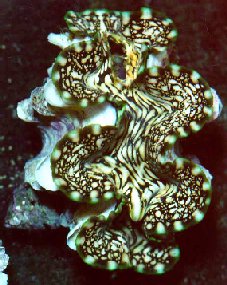
Source of Image
Notes for Chapter 16:
Mollusca (Molluscs or Mollusks)
Click link to return to Lecture
Schedule
or back to Chapter 14 or Chapter
15
or ahead to Chapter 17
Chapter 16 Assignment:
All; RQ 16: 2,5,6,8,9,11,13
(2 Lectures)
Introduction: A Significant Space (coelom)
Featured organism: Fluted giant clam (Tridacna
Squamosa)
More Links: 1
- 2
- 3 - 4
- 5 - 6
I. Molluscs
Squids, Snails, Bivalves,
and Chitons
More
Links
II. Form and Function
Key Terms:
radula
visceral mass
mantle
mantle cavity
ctenidium
foot
coiling vs. torsion
siphuncle
Common molluscan features (none in all):
radula
muscular creeping foot
visceral mass (gut, blood, gonads)
mantle
shell
mantle cavity
ctenidia (gills)
trochophore larva
spiral cleavage
coelomic heart cavity
hemocyanin blood pigments
Molluscs and Humans
1. Positive aspects
Food (e.g., oyster farm produces 20 times meat/acre as a cattle farm)
Rich cultural history, inspirations in art
Currency (NW Native Americans used scaphopods – "wompom")
2. Negative aspects
Introduced pests
slugs
carnivorous snails in Pacific islands
Corbicula – a clam introduced "for fish bait" from Asia, clogs dams
zebra mussel – larvae transported in bilge water to Great Lakes
– huge ecological and financial impactBankia – bivalve "shipworm" bores into wood, tremendous destruction
Schistosomiasis flatworm parasite uses snails for intermediate host
– widespread in tropical areas with primitive sewage treatment
venomous – snail Conus and blue-ringed octopus can be deadly
III. Classes of Molluscs
a) Chitons, Tusk Shells,
Monoplacophorans, and Solenogastors
(Classes Polyplacophora,
Scaphopoda,
Monoplacophora,
and
Aplacophora)
Prof.
Eernisse works on Chitons!
Here is his compilation of Web
Images
(More links:
1 -
2 - 3
- 4 - 5
- 6 - 7
- 8
- 9 - 10
- 11)
"aplacophorans"
mostly in deep sea and poorly known
lack shell but have spicules in mantle, like a chiton
with or without foot groove
with or without gill (ctenidium)
have radula (secondarily lost in some)
little evidence of serial repetition
chitons
eight shell plates
repeated gills, shell muscles
creeping foot
radula like a limpet/monoplacophoran
teeth mineralized with magnetite (iron)
many sensory organs in shells and girdle
serial repetition (ancestral or derived?)
conchiferans
single shell, discrete shell gland
periostracum
prismatic and nacreous shell layers
mantle margin with three folds
crystalline style
no spicules in mantle
some have serial repetition (monoplacophorans, Nautilus)
b) Snails and Their
Relatives (Class Gastropoda)
terms: trochophore and veliger
larval stages, velum,
protoconch (larval shell)
1) Prosobranch snails are grazers, predators, suspension feeders.
2) Opisthobranchs
(sea slugs including nudibranchs)
are
few in species, diverse in life-styles.
Featured Pelagic Molluscs:
floating
purple snail (Janthina janthina)
heteropods
(planktonic swimming snails)
pteropods
(planktonic opisthobranchs)
blue
dragon "solar powered" sea slug (Pteraeolidia
janthina)
Gastropods (snails, slugs: > 50,000 species)
Paraphyletic group: "prosobranchs"
(all snails except the clade of opisthobranchs + pulmonates)
about half of all snail species
includes, limpets, abalones, keyholes,
diverse marine snails including trochaceans, neogastropods
Opisthobranchs –diverse but few species
shell internal or absent
includes Aplysia, nudibranchs
(these are very attractive "sea slugs"
– Links: 1 - 2 - 3 - 4 - 5 - 6 - 7 - 8 - 9)
Pulmonates
half of all snail species
lungs instead of gills
lining of mantle cavity takes over
coincide with invasion of land
Evolutionary Trends in Gastropod Gills (see Fig. 16-17)
"prosobranchs"
two gills (abalone, key hole limpets)
reduce right gill
loss of right gill (limpets)
monopectinate gill fused to mantle
opisthobranchs –secondary gill
pulmonates – lungs
Gastropod Features:1. Torsion – important synapomorphy (does not = coiling)
upper part is twisted nearly 180° from lower part (See Fig. 16-13)
mantle cavity moves from back to front
hypotheses:
helps larval "veliger" pull its head inside its shell
(Walter Garstang proposed this as a poem:
"Ballad of the veliger or how the gastropod got its twist")
helps the adult carry weight of shell
(Proposed by German biologists even earlier)2. Coiling
snails protect themselves:
clamping, withdrawing, locomotion
coiling helps
a high uncoiled shell would be hard to carry
high center of gravity, frontal cross-section great
shell is usually tilted (See Fig. 16-14)
most shells coil to right (dextral)
some coil to left (sinistral)
Parameters of coiling (pioneered by David Raup in 1960s;
see p. 329 or this online shell-generating Java applet):amount of translation (T)
isotrophic (T = 0) [planispiral]
orthostrophic (T is negative)
hyperstrophic (T is positive)
whorl expansion rate (W)
long pointed shells (W is low)
broad shells (W is high)
distance from axis of coiling (D)
hollow center as D increases
Of possible combinations of T, W, D
snail examples for many but not all
here are some example combinations:

c) Clams, Oysters, Mussels,
Scallops and Their Relatives
(Class Bivalvia)
terms: siphon
d) Octopuses,
Squids, Cuttlefish, and Nautiluses
(Class Cephalopoda)
terms: pen
Featured
organisms:
Chambered
nautilus (Nautilus)
-
More Links: 1
- 2 - 3
- 4
- 5 -
6
Cuttlefish
(Sepia)
Giant
squid (Architeuthis
dux) -
More Links: 1
- 2
Giant
Pacific octopus (Octopus
dofleini)
Cephalopods
have large head like their snail relatives
all predators
use muscles, not cilia, for locomotion (siphon)
synapomorphy is siphuncle, but this is lost as shell is internalized, reduced
Nautilus –> Spirula –> Sepia –> Loligo
Nautilus has eyes like pinhole cameras
Squids have much more complex eyes
eye design is direct, not indirect as in vertebrates
IV. Phylogeny and Evolution
Classification based on Fig. 16-42
Mollusca (> 100,000 species – esp. snails)
Caudofoveata (burrowers)
Solenogasters (cnidarian-feeders)
Testaria (shelled molluscs)
Polyplacophora (chitons)
Conchifera (discrete shell gland)
(incl. snails, squids, clams, etc.)
Note: Testaria and Conchifera are not labeled in Fig. 16-42
– Can you find
them?
Click link to return to Lecture
Schedule
or back to Chapter 14 or Chapter
15
or ahead to Chapter 17
This page created 9/28/01 © D.J. Eernisse, Last Modified 9/28/01, Links Last Completely Checked 9/28/01